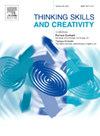Modality and fidelity: Understanding how creative stimulus combinations impact design outcomes and process across different conceptual design phases
IF 4.5
2区 教育学
Q1 Social Sciences
引用次数: 0
Abstract
During conceptual design, creative stimuli are an external source of inspiration to support students’ ideation process. Although existing research has explored the roles of creative stimuli, they rarely consider the intertwined influence brought by stimuli’s multiple characteristics, and overlook variations in stimuli’s effectiveness at different design phases. To fill this gap, this research conducted a experiment, involving 72 design students in a three-phase design process and presenting combinations of textual and visual stimuli at distinct fidelities. We assessed different stimulus combinations’ influence on creativity, and employed behavior coding and linkograph to reveal students’ behavior and cognitive patterns throughout the process. The results revealed the mutual influence between the fidelity of texts and images, and students commonly needed more concrete stimuli in later design phases. Furthermore, students provided with different stimulus combinations exhibited variations in time allocation for behaviors including task analysis, idea generation, and evaluation, and they employed distinct approaches to generate new ideas. These findings highlight the necessity for design educators to dynamically provide creative stimuli based on the design phase, educational objective, and students’ state.
模式和保真度:了解创意刺激组合如何影响不同概念设计阶段的设计成果和过程
在概念设计过程中,创意刺激是支持学生构思过程的外部灵感来源。现有研究虽然探讨了创意刺激的作用,但很少考虑刺激的多种特性所带来的交织影响,也忽视了刺激在不同设计阶段的效果差异。为了填补这一空白,本研究进行了一次 3×3 实验,让 72 名设计专业的学生参与三个阶段的设计过程,并以不同的保真度呈现文字和视觉刺激组合。我们评估了不同刺激组合对创造力的影响,并采用行为编码和链接图揭示了学生在整个过程中的行为和认知模式。结果显示,文字和图像的保真度之间存在相互影响,学生在后期设计阶段通常需要更具体的刺激。此外,不同刺激组合的学生在任务分析、创意生成和评估等行为的时间分配上表现出差异,他们采用了不同的方法来生成新的创意。这些发现凸显了设计教育者根据设计阶段、教育目标和学生状态动态提供创意刺激的必要性。
本文章由计算机程序翻译,如有差异,请以英文原文为准。
求助全文
约1分钟内获得全文
求助全文
来源期刊

Thinking Skills and Creativity
EDUCATION & EDUCATIONAL RESEARCH-
CiteScore
6.40
自引率
16.20%
发文量
172
审稿时长
76 days
期刊介绍:
Thinking Skills and Creativity is a new journal providing a peer-reviewed forum for communication and debate for the community of researchers interested in teaching for thinking and creativity. Papers may represent a variety of theoretical perspectives and methodological approaches and may relate to any age level in a diversity of settings: formal and informal, education and work-based.
 求助内容:
求助内容: 应助结果提醒方式:
应助结果提醒方式:


